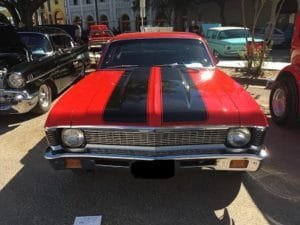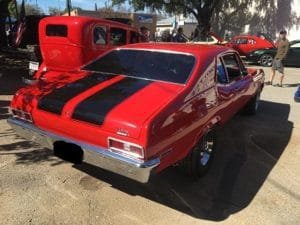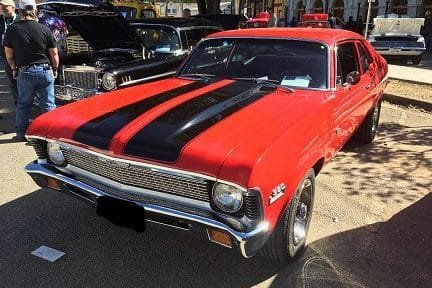Featured is a beautiful 1972 Chevrolet Nova. The 1972 Nova was a part of the third generation which covered model years 1967 through 1972. In all, the Chevy II Nova was produced for five generations from 1961–1979; 1985–1988. The Nova was first produced as a lower cost compact economy car but beginning in the mid 1960’s built models considered muscle cars.
Of significance is that In 1969 Chevrolet removed the “Chevy II” badge and replaced it with “Nova by Chevrolet“. The Chevy II badge above the grille was replaced with the well known bow tie.

The Chevy Nova
The Nova (officially named Chevy II) began as a car that Chevrolet needed badly to compete against the new compact car wars that were growing. The Nova design was unique because it was not inspired by other Chevy models. It was a true original. The Nova was an entirely new design laid out on the Chevrolet drawing board.
The Chevy II was a small car by the standards of 1962 but not as small as some you might see today. The Chevy Nova had a very successful 16 year run.
The 1972 Chevy Nova
Chevy Nova models for 1972 included a two door coupe and a four door sedan.
The 1972 Nova exterior was basically identical to the 1971 model with the exception of a slight bevel on the hood and a recessed front license plate area. The changes that were made were mechanical.

Chevrolet offered three engines for the Nova during 1972.
One was a a 110 horsepower inline six , a 130 horsepower 307 cubic inch V-8. Also offered was the biggest engine being the 350 cubic inch V-8 delivering 200 HP. Novas were popular as drag racers due to their light weight and powerful engines.
The new federal emission and safety regulations caused a quick change in horsepower offered and the horsepower shown for the 1972 Chevy engines is a result of lower compressions. In addition to the federal regulations was the higher insurance premiums demanded for muscle cars. This was usually called a “performance car surcharge”.
The standard transmission was a column mounted three-speed manual. Two optional transmissions were the Torque Drive and three speed Powerglide. The Torque Drive which is rare is a manually shifted two-speed “semi-automatic. The Torque-Drive, which was created for four and six cylinder engines only, was used from 1968 through 1971.Also available was the three speed Turbo Hydra-Matic 350 and 400 automatics.
Standard brakes were four wheel hydraulic drums, with power assist optional. Front disc brakes were also optional.
1972 Chevy Nova front suspension had General Motors’s dependable independent system featuring unequal-length A-arms and coil springs. Rear suspension consisted of a solid axle, coil springs, and a four-link Panhard bar.
Dimensions include a 111.0 inch wheelbase, 189.4 inch overall outside length, 72.4 inch width. Curb weight is about 3.030 lbs.
Total 1972 Chevy Nova production was 349,700 vehicles. Out of that amount there were 210,000 built with V-8 engines and only 12,300 that had the SS package.
Related Auto Museum Online articles are found on the links below…
Reference material includes…The Complete Book of Classic Chevrolet Muscle Cars: 1955-1974 by Mike Mueller…COPO Camaro, Chevelle & Nova: Chevrolet’s Ultimate Muscle Cars by Matt Avery. Compete Book of Collectable Cars by the Editors of Consumer Guide.
1972 Chevrolet Nova Collector Automobile
 Many Chevrolet automobiles from the mid 1960’s through the early 1970’s are popular collector cars. Many car enthusiasts say that 1965 was the first year of the Chevy II muscle car. The Chevy Nova is also considered one of Chevrolet’s most successful models.
Many Chevrolet automobiles from the mid 1960’s through the early 1970’s are popular collector cars. Many car enthusiasts say that 1965 was the first year of the Chevy II muscle car. The Chevy Nova is also considered one of Chevrolet’s most successful models.
For the 1972 model year there were several engines available for the Nova though compression numbers were throttled down by then due to federal regulations.
Current asking prices for the 1972 Nova’s will take into account which specific model and engine. Some of the Chevy Nova big block cars are considered pretty valuable.
Current asking prices for the 1972 Chevy Nova examples in excellent restored condition can range from the $30,000 to $70,000 area.
(Article and photos copyright Auto Museum Online)
